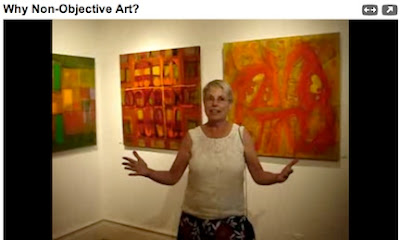
In the YouTube video "Why Non-Objective Art?", taped at a gallery talk at The Edward Hopper House Art Center in Nyack, New York, Taetsch describes how she works in layers, using methods that will be familiar to you from class. After going through the big gestural phase of the painting, she steps back to see what the painting needs. She turns it around in all four directions, not only upside down.
She talks also about how everything she sees influences her work – not only art she looks at. Colors and symbols are important to her. But what is most important to her is the experience of painting, the process itself – she has no idea, when she's beginning, of where the painting will lead her.
She also talks about how she doesn't think in words when she's painting – she thinks visually. It's the difference between getting out of our linear, logical, right-brained mode of thinking and shifting into visual, holistic, left-brained processing. Different painters have different ways of making that shift – painting to music is a good method.
It's a wonderful, thoughtful conversation about how painters paint and what goes into the process of creating art. You can also see Lynne Taetsch talk about her painting process, especially about working in left-brain mode, and abstract art in the video "Painting Abstract Art." You can find her work online both in the video "Modern Art: Paintings by Lynne Taetsch," and at her website ArtByLT.com.













